Zeqing Wang
Minute-Long Videos with Dual Parallelisms
May 29, 2025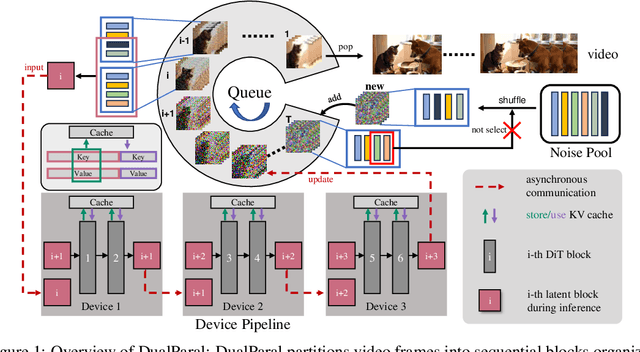


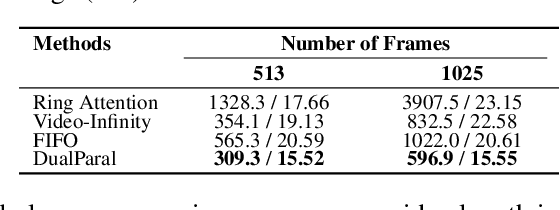
Abstract:Diffusion Transformer (DiT)-based video diffusion models generate high-quality videos at scale but incur prohibitive processing latency and memory costs for long videos. To address this, we propose a novel distributed inference strategy, termed DualParal. The core idea is that, instead of generating an entire video on a single GPU, we parallelize both temporal frames and model layers across GPUs. However, a naive implementation of this division faces a key limitation: since diffusion models require synchronized noise levels across frames, this implementation leads to the serialization of original parallelisms. We leverage a block-wise denoising scheme to handle this. Namely, we process a sequence of frame blocks through the pipeline with progressively decreasing noise levels. Each GPU handles a specific block and layer subset while passing previous results to the next GPU, enabling asynchronous computation and communication. To further optimize performance, we incorporate two key enhancements. Firstly, a feature cache is implemented on each GPU to store and reuse features from the prior block as context, minimizing inter-GPU communication and redundant computation. Secondly, we employ a coordinated noise initialization strategy, ensuring globally consistent temporal dynamics by sharing initial noise patterns across GPUs without extra resource costs. Together, these enable fast, artifact-free, and infinitely long video generation. Applied to the latest diffusion transformer video generator, our method efficiently produces 1,025-frame videos with up to 6.54$\times$ lower latency and 1.48$\times$ lower memory cost on 8$\times$RTX 4090 GPUs.
TimeCausality: Evaluating the Causal Ability in Time Dimension for Vision Language Models
May 21, 2025Abstract:Reasoning about temporal causality, particularly irreversible transformations of objects governed by real-world knowledge (e.g., fruit decay and human aging), is a fundamental aspect of human visual understanding. Unlike temporal perception based on simple event sequences, this form of reasoning requires a deeper comprehension of how object states change over time. Although the current powerful Vision-Language Models (VLMs) have demonstrated impressive performance on a wide range of downstream tasks, their capacity to reason about temporal causality remains underexplored. To address this gap, we introduce \textbf{TimeCausality}, a novel benchmark specifically designed to evaluate the causal reasoning ability of VLMs in the temporal dimension. Based on our TimeCausality, we find that while the current SOTA open-source VLMs have achieved performance levels comparable to closed-source models like GPT-4o on various standard visual question answering tasks, they fall significantly behind on our benchmark compared with their closed-source competitors. Furthermore, even GPT-4o exhibits a marked drop in performance on TimeCausality compared to its results on other tasks. These findings underscore the critical need to incorporate temporal causality into the evaluation and development of VLMs, and they highlight an important challenge for the open-source VLM community moving forward. Code and Data are available at \href{https://github.com/Zeqing-Wang/TimeCausality }{TimeCausality}.
Tracking-Aware Deformation Field Estimation for Non-rigid 3D Reconstruction in Robotic Surgeries
Mar 04, 2025Abstract:Minimally invasive procedures have been advanced rapidly by the robotic laparoscopic surgery. The latter greatly assists surgeons in sophisticated and precise operations with reduced invasiveness. Nevertheless, it is still safety critical to be aware of even the least tissue deformation during instrument-tissue interactions, especially in 3D space. To address this, recent works rely on NeRF to render 2D videos from different perspectives and eliminate occlusions. However, most of the methods fail to predict the accurate 3D shapes and associated deformation estimates robustly. Differently, we propose Tracking-Aware Deformation Field (TADF), a novel framework which reconstructs the 3D mesh along with the 3D tissue deformation simultaneously. It first tracks the key points of soft tissue by a foundation vision model, providing an accurate 2D deformation field. Then, the 2D deformation field is smoothly incorporated with a neural implicit reconstruction network to obtain tissue deformation in the 3D space. Finally, we experimentally demonstrate that the proposed method provides more accurate deformation estimation compared with other 3D neural reconstruction methods in two public datasets.
SAMCL: Empowering SAM to Continually Learn from Dynamic Domains
Dec 06, 2024Abstract:Segment Anything Model (SAM) struggles with segmenting objects in the open world, especially across diverse and dynamic domains. Continual segmentation (CS) is a potential technique to solve this issue, but a significant obstacle is the intractable balance between previous domains (stability) and new domains (plasticity) during CS. Furthermore, how to utilize two kinds of features of SAM, images and prompts, in an efficient and effective CS manner remains a significant hurdle. In this work, we propose a novel CS method, termed SAMCL, to address these challenges. It is the first study to empower SAM with the CS ability across dynamic domains. SAMCL decouples stability and plasticity during CS by two components: $\textit{AugModule}$ and $\textit{Module Selector}$. Specifically, SAMCL leverages individual $\textit{AugModule}$ to effectively and efficiently learn new relationships between images and prompts in each domain. $\textit{Module Selector}$ selects the appropriate module during testing, based on the inherent ability of SAM to distinguish between different domains. These two components enable SAMCL to realize a task-agnostic method without any interference across different domains. Experimental results demonstrate that SAMCL outperforms state-of-the-art methods, achieving an exceptionally low average forgetting of just $0.5$%, along with at least a $2.5$% improvement in transferring to unseen domains. Moreover, the tunable parameter consumption in AugModule is about $0.236$MB, marking at least a $23.3$% reduction compared to other fine-tuning methods.
Is this Generated Person Existed in Real-world? Fine-grained Detecting and Calibrating Abnormal Human-body
Nov 21, 2024



Abstract:Recent improvements in visual synthesis have significantly enhanced the depiction of generated human photos, which are pivotal due to their wide applicability and demand. Nonetheless, the existing text-to-image or text-to-video models often generate low-quality human photos that might differ considerably from real-world body structures, referred to as "abnormal human bodies". Such abnormalities, typically deemed unacceptable, pose considerable challenges in the detection and repair of them within human photos. These challenges require precise abnormality recognition capabilities, which entail pinpointing both the location and the abnormality type. Intuitively, Visual Language Models (VLMs) that have obtained remarkable performance on various visual tasks are quite suitable for this task. However, their performance on abnormality detection in human photos is quite poor. Hence, it is quite important to highlight this task for the research community. In this paper, we first introduce a simple yet challenging task, i.e., \textbf{F}ine-grained \textbf{H}uman-body \textbf{A}bnormality \textbf{D}etection \textbf{(FHAD)}, and construct two high-quality datasets for evaluation. Then, we propose a meticulous framework, named HumanCalibrator, which identifies and repairs abnormalities in human body structures while preserving the other content. Experiments indicate that our HumanCalibrator achieves high accuracy in abnormality detection and accomplishes an increase in visual comparisons while preserving the other visual content.
Efficient Continual Learning with Low Memory Footprint For Edge Device
Jul 15, 2024



Abstract:Continual learning(CL) is a useful technique to acquire dynamic knowledge continually. Although powerful cloud platforms can fully exert the ability of CL,e.g., customized recommendation systems, similar personalized requirements for edge devices are almost disregarded. This phenomenon stems from the huge resource overhead involved in training neural networks and overcoming the forgetting problem of CL. This paper focuses on these scenarios and proposes a compact algorithm called LightCL. Different from other CL methods bringing huge resource consumption to acquire generalizability among all tasks for delaying forgetting, LightCL compress the resource consumption of already generalized components in neural networks and uses a few extra resources to improve memory in other parts. We first propose two new metrics of learning plasticity and memory stability to seek generalizability during CL. Based on the discovery that lower and middle layers have more generalizability and deeper layers are opposite, we $\textit{Maintain Generalizability}$ by freezing the lower and middle layers. Then, we $\textit{Memorize Feature Patterns}$ to stabilize the feature extracting patterns of previous tasks to improve generalizability in deeper layers. In the experimental comparison, LightCL outperforms other SOTA methods in delaying forgetting and reduces at most $\textbf{6.16$\times$}$ memory footprint, proving the excellent performance of LightCL in efficiency. We also evaluate the efficiency of our method on an edge device, the Jetson Nano, which further proves our method's practical effectiveness.
Jump-teaching: Ultra Efficient and Robust Learning with Noisy Label
May 28, 2024

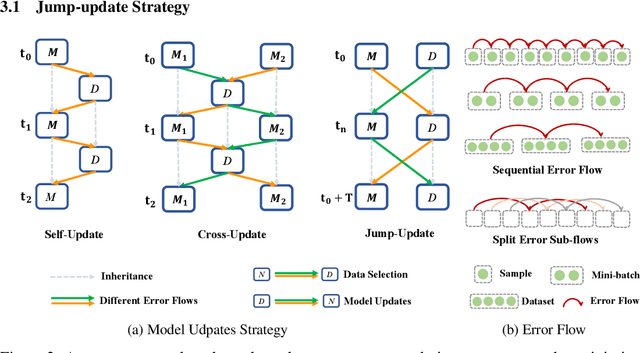

Abstract:Sample selection is the most straightforward technique to combat label noise, aiming to distinguish mislabeled samples during training and avoid the degradation of the robustness of the model. In the workflow, $\textit{selecting possibly clean data}$ and $\textit{model update}$ are iterative. However, their interplay and intrinsic characteristics hinder the robustness and efficiency of learning with noisy labels: 1) The model chooses clean data with selection bias, leading to the accumulated error in the model update. 2) Most selection strategies leverage partner networks or supplementary information to mitigate label corruption, albeit with increased computation resources and lower throughput speed. Therefore, we employ only one network with the jump manner update to decouple the interplay and mine more semantic information from the loss for a more precise selection. Specifically, the selection of clean data for each model update is based on one of the prior models, excluding the last iteration. The strategy of model update exhibits a jump behavior in the form. Moreover, we map the outputs of the network and labels into the same semantic feature space, respectively. In this space, a detailed and simple loss distribution is generated to distinguish clean samples more effectively. Our proposed approach achieves almost up to $2.53\times$ speedup, $0.46\times$ peak memory footprint, and superior robustness over state-of-the-art works with various noise settings.
Mimic: Speaking Style Disentanglement for Speech-Driven 3D Facial Animation
Dec 18, 2023Abstract:Speech-driven 3D facial animation aims to synthesize vivid facial animations that accurately synchronize with speech and match the unique speaking style. However, existing works primarily focus on achieving precise lip synchronization while neglecting to model the subject-specific speaking style, often resulting in unrealistic facial animations. To the best of our knowledge, this work makes the first attempt to explore the coupled information between the speaking style and the semantic content in facial motions. Specifically, we introduce an innovative speaking style disentanglement method, which enables arbitrary-subject speaking style encoding and leads to a more realistic synthesis of speech-driven facial animations. Subsequently, we propose a novel framework called \textbf{Mimic} to learn disentangled representations of the speaking style and content from facial motions by building two latent spaces for style and content, respectively. Moreover, to facilitate disentangled representation learning, we introduce four well-designed constraints: an auxiliary style classifier, an auxiliary inverse classifier, a content contrastive loss, and a pair of latent cycle losses, which can effectively contribute to the construction of the identity-related style space and semantic-related content space. Extensive qualitative and quantitative experiments conducted on three publicly available datasets demonstrate that our approach outperforms state-of-the-art methods and is capable of capturing diverse speaking styles for speech-driven 3D facial animation. The source code and supplementary video are publicly available at: https://zeqing-wang.github.io/Mimic/
Towards Top-Down Reasoning: An Explainable Multi-Agent Approach for Visual Question Answering
Nov 29, 2023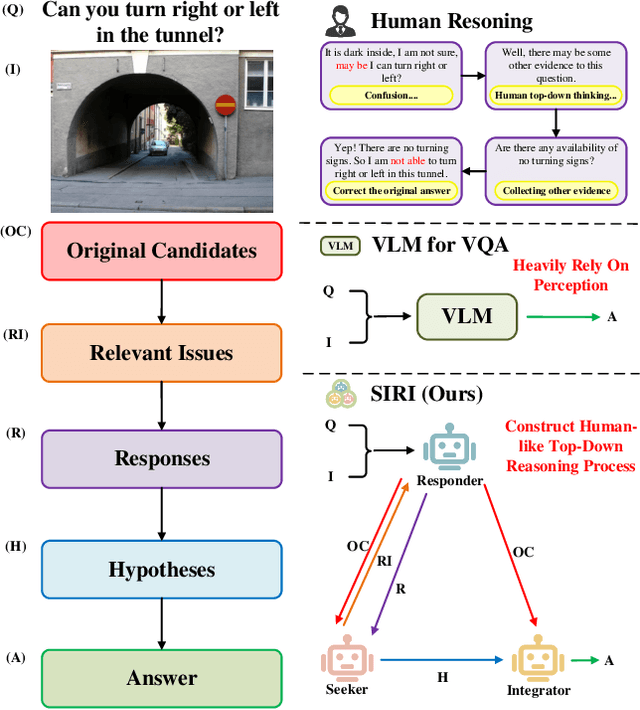
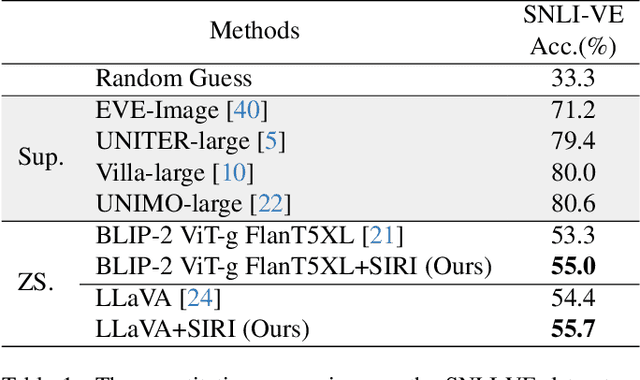
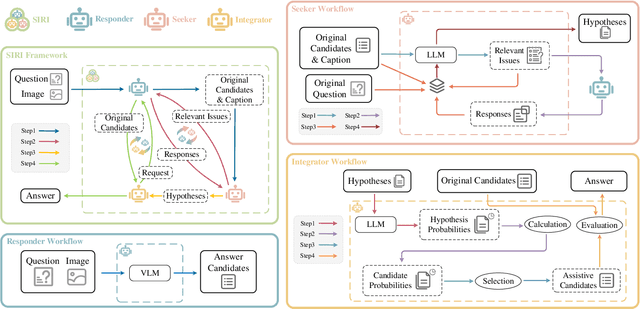
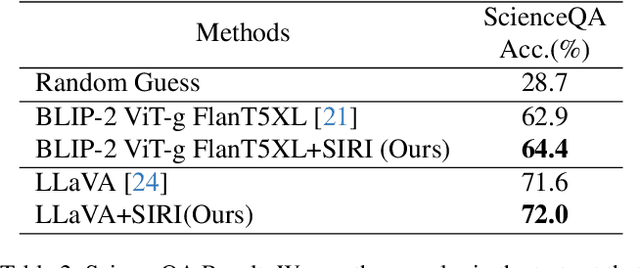
Abstract:Recently, Vision Language Models (VLMs) have gained significant attention, exhibiting notable advancements across various tasks by leveraging extensive image-text paired data. However, prevailing VLMs often treat Visual Question Answering (VQA) as perception tasks, employing black-box models that overlook explicit modeling of relationships between different questions within the same visual scene. Moreover, the existing VQA methods that rely on Knowledge Bases (KBs) might frequently encounter biases from limited data and face challenges in relevant information indexing. Attempt to overcome these limitations, this paper introduces an explainable multi-agent collaboration framework by tapping into knowledge embedded in Large Language Models (LLMs) trained on extensive corpora. Inspired by human cognition, our framework uncovers latent information within the given question by employing three agents, i.e., Seeker, Responder, and Integrator, to perform a top-down reasoning process. The Seeker agent generates relevant issues related to the original question. The Responder agent, based on VLM, handles simple VQA tasks and provides candidate answers. The Integrator agent combines information from the Seeker agent and the Responder agent to produce the final VQA answer. Through the above collaboration mechanism, our framework explicitly constructs a multi-view knowledge base for a specific image scene, reasoning answers in a top-down processing manner. We extensively evaluate our method on diverse VQA datasets and VLMs, demonstrating its broad applicability and interpretability with comprehensive experimental results.
VisualProg Distiller: Learning to Fine-tune Non-differentiable Visual Programming Frameworks
Sep 18, 2023Abstract:As an interpretable and universal neuro-symbolic paradigm based on Large Language Models, visual programming (VisualProg) can execute compositional visual tasks without training, but its performance is markedly inferior compared to task-specific supervised learning models. To increase its practicality, the performance of VisualProg on specific tasks needs to be improved. However, the non-differentiability of VisualProg limits the possibility of employing the fine-tuning strategy on specific tasks to achieve further improvements. In our analysis, we discovered that significant performance issues in VisualProg's execution originated from errors made by the sub-modules at corresponding visual sub-task steps. To address this, we propose ``VisualProg Distiller", a method of supplementing and distilling process knowledge to optimize the performance of each VisualProg sub-module on decoupled visual sub-tasks, thus enhancing the overall task performance. Specifically, we choose an end-to-end model that is well-performed on the given task as the teacher and further distill the knowledge of the teacher into the invoked visual sub-modules step-by-step based on the execution flow of the VisualProg-generated programs. In this way, our method is capable of facilitating the fine-tuning of the non-differentiable VisualProg frameworks effectively. Extensive and comprehensive experimental evaluations demonstrate that our method can achieve a substantial performance improvement of VisualProg, and outperforms all the compared state-of-the-art methods by large margins. Furthermore, to provide valuable process supervision for the GQA task, we construct a large-scale dataset by utilizing the distillation process of our method.
 Add to Chrome
Add to Chrome Add to Firefox
Add to Firefox Add to Edge
Add to Edge